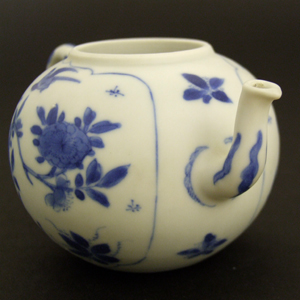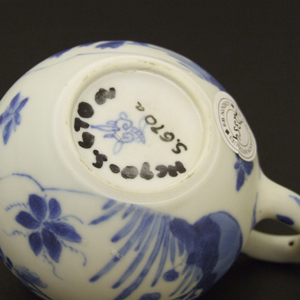
VUNG TAU CARGO c.1690 – 1700 Kangxi Porcelain
A Rare Small Kangxi Blue and White Porcelain Teapot from the Vung Tau Cargo Shipwreck c.1690-1700.
SOLD
- Condition
- No damage but the glaze is semi-matt due to sea immersion. The cobalt blue still appears bright and the glaze is very clean.
- Size
- Length : 12 cm (4 3/4 inches)
- Provenance
- Probably Christie`s Amsterdam, The Vung Tau Cargo, Chinese Export Porcelain, April 1992. No label but with excavation numbering to the base and inside cover. A Private English Collection of Chinese Blue and White Porcelain.
- Stock number
- 22354
- References
- Only 15 teapots of this type were for offered for sale at the original auction, see : The Vung Tau Cargo, Chinese Export Porcelain, Christie`s Amsterdam, 7 and 8th of April 1992, lots 223 to 227. For a group of very similar Kangxi Porcelain teapots see : Porcelain From The Vung Tau Wreck - The Hallstrom Excavation (By Christian J.A. Jorg and Michael Fletcher,Sun Tree Publishing Ltd,U.K. ISBN 981-04-5208-X.) page 63 figure 46.
Information
The Vung Tau Cargo :
The Vung Tau wreck was discovered by Vietnamese fishermen and turned into a salvage operation. Some archaeological information was however saved. It was discovered for example that some of the ship’s timbers were badly charred, suggesting that the ship had met with one of the most feared problems that can arise at sea: fire. The Chinese junk was en route to the town of Batavia (present day Jakarta) in Indonesia. Batavia was the centre for the Dutch East India Company (V.O.C.). The V.O.C. was the first Dutch company to be funded by shareholders. It began as an attempt to unify the various Dutch companies trading in the East, that were competing against each other. By the late 17th century it had become a massive operation. Central control was supposed to come from Amsterdam, with Batavia and the other bases taking a secondary role. Given the difficult and slow communications and the need to deal with the reality of local practicalities as and when necessary, Batavia tended in practice to adapt or to modify the instructions that had been issued from Amsterdam. Batavia was a large and busy town, built following a Dutch model, complete with a castle, administrative buildings, law courts, churches and a canal. The complex trading relationship the Dutch had with Asia was too involved to describe here in any detail but it is interesting simply to note that Batavia was the most important trans-shipment centre the Dutch had. Goods would arrive from Holland, be traded and oriental goods would be sent back to Holland. About 70% of the Vung Tau cargo was to have been trans-shipped to Holland on an East Indiaman vessel from Batavia. But the Vung Tau junk never reached the Dutch trans-shipment centre. The great interest in Chinese porcelain in England had been prompted by the arrival of Queen Mary from Holland, and the enthusiasm she brought with her for Chinese Blue and White porcelain. Her palaces in Holland, and later in this country, were filled with the Kangxi Blue and White porcelain that she loved so much. Unlike the individual pieces of Blue and White from the period of the Hatcher Cargo (c.1643), the Kangxi porcelain objects from the Vung Tau Cargo were mostly to have been displayed as a collection. The pieces had been made as sets, to be arranged together for impact, and displayed on gilt stands and brackets made for the purpose. These were used to create a rich glittering effect together with garniatures of vases, miniature vases, dishes, and cups and saucers reaching from floor to ceiling. These massed baroque displays have long since been removed from many palaces. However, in Kensington Palace, as part of its restoration, the curators are attempting to replace some of the Kangxi porcelain. Part of the display will include items from the Vung Tau Cargo. Perhaps destined originally for a royal palace, it could be said that the porcelain is finally arriving at its destination – albeit three hundred years or so late! Although some of this cargo might indeed have been intended for a palace, it represented a typical cargo produced for the flourishing Dutch middle and upper class clientèle. A use would have been found too for some of the less purely luxurious and more functional items. Tea, coffee and hot chocolate - newly fashionable beverages - were luxuries that only the wealthy could afford. All three were both exotic and expensive and thus fine porcelain, instead of native European pottery was needed. Many different shapes of blue and white porcelain cups, some with covers, and saucers were included in the cargo.




